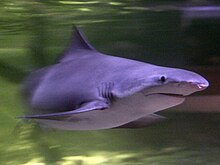River sharks
| River sharks | ||||||||||||
|---|---|---|---|---|---|---|---|---|---|---|---|---|

Spear tooth shark ( Glyphis glyphis ) |
||||||||||||
| Systematics | ||||||||||||
|
||||||||||||
| Scientific name | ||||||||||||
| Glyphis | ||||||||||||
| Agassiz , 1843 |
The river sharks ( Glyphis ) are a genus of the requiem sharks (Carcharhinidae). It currently comprises five species that prefer to live in fresh and brackish water in large rivers.
Appearance and characteristics
The gray-brown Glyphis species, usually between one and a maximum of three meters long, look very similar in shape to the representatives of the genus Carcharhinus , into which they were originally also classified. Like this one, they have an anal fin and two dorsal fins , the front of which is larger than the rear, and are also characterized by five gill slits , round eyes with special eyelids and blade-like single-pointed teeth. In addition, they do not have an injection hole either , the cutting edges of the upper jaw are sawn, but those of the lower jaw are narrow and long and only sawn at the tips. The second dorsal fin is significantly higher than in the Carcharhinus species, and the upper pit of the caudal peduncle is a longitudinal pit while the Carcharhinus species have a crescent-shaped pit.
Way of life
Glyphis species are strong swimmers and probably predatory feed on various fish , but this has only been very little researched. Further details of their way of life are also largely unknown. It is assumed that the Gangeshai will probably have their young in fresh water, the females are viviparous. Documented attacks of this type on humans or corpses are likely due to a confusion with the bull or bull shark ( Carcharhinus leucas ), which can also be found in freshwater.
distribution
The Gangeshai lives in the estuaries of large rivers in the West Bengal region such as the Ganges and the Hugli , maybe also in Pakistan (possibly confused with the bull shark). The spear tooth shark lives in the coastal regions of New Guinea and northern Australia . The other species occur at the mouth of the Irrawaddy in Burma, on the coast of northeast Kalimantan , in the Fly River in New Guinea and on the coast of northern Australia.
Systematics
Today five species are assumed for the genus Glyphis , two of which were previously assigned to the spear tooth shark. Since the populations of the spear tooth shark differ significantly in terms of the number of vertebrae , it is not fully clear whether it is one or more species. Compagno et al. 2005 adopt three further, as yet undescribed species in the area of the Indo-Pacific, of which Glyphis garricki was described in 2008 by Compagno, White and Last and the Borneo river shark ( Glyphis fowlerae ) in 2010 by Compagno, White and Cavanagh. The remaining, undescribed species is known from the coasts of Bangla Desh and Borneo and is the basal sister species of all other river sharks.
- Borneo river shark ( Glyphis fowlerae )
- Gangeshai ( Glyphis gangeticus )
- Glyphis garricki
- Spear tooth shark ( Glyphis glyphis )
- Irrawaddy river shark ( Glyphis siamensis ), probably not a separate species, but a population of Glyphis gangeticus
- Glyphis sp. Bangla Desh and Borneo
supporting documents
- ↑ Compagno et al., Pp. 309-312.
- ↑ LJV Compagno, WT White, PR Last: Glyphis garricki sp. nov., a new species of river shark (Carcharhiniformes: Carcharhinidae) from northern Australia and Papua New Guinea, with a redescription of Glyphis glyphis (Müller & Henle, 1839) . In: PR Last, WT White, JJ Pogonoski (Ed.): Descriptions of new Australian Chondrichthyans . CSIRO Marine and Atmospheric Research, 2008, ISBN 978-1-921424-18-2 , pp. 203-226 .
- ↑ LJV Compagno, WT White, RD Cavanagh: Glyphis fowlerae sp. nov., a new species of river shark (Carcharhiniformes; Carcharhinidae) from northeastern Borneo. In: PP Last, WT White, JJ Pogonoski (Ed.): Descriptions of new sharks and rays from Borneo. (CSIRO Marine and Atmospheric Research Paper no. 32), pp. 29-44. ( Full text ; PDF; 7.6 MB)
- ↑ Data sheet from the Australian Department of the Environment, Water, Heritage and the Arts, Canberra
- ↑ a b c Chenhong Lia, Shannon Corrigan, Lei Yang, Nicolas Straube, Mark Harris, Michael Hofreiter , William T. White and Gavin JP Naylorb: DNA capture reveals transoceanic gene flow in endangered river sharks. 13302-13307 | PNAS | October 27, 2015 | vol. 112 | no.43
literature
- Kuno Sch. Steuben : The sharks of the seven seas: species, way of life and sporting catch. Parey, Berlin 1989, ISBN 3-490-44314-4 , pp. 100-101.
- Leonard Compagno , Marc Dando, Sarah Fowler: Sharks of the World. Princeton University Press , Princeton / Oxford 2005, ISBN 0-691-12072-2 , pp. 309-313.
Web links
- River sharks on Fishbase.org (English)
